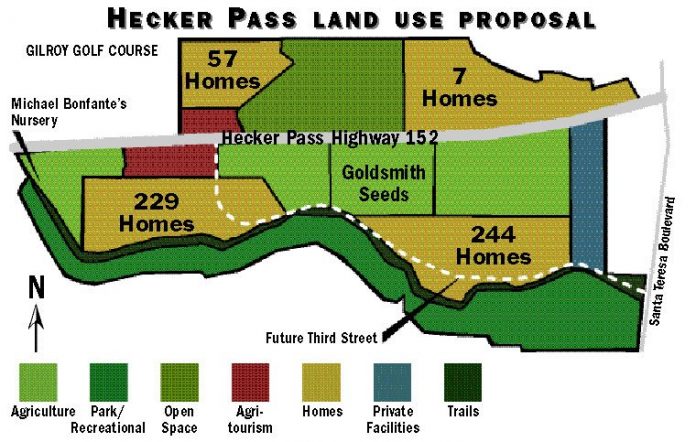GILROY
– In a few short years, Gilroy’s most scenic thoroughfare could
be home to three large clusters of housing developments – and that
image is not sitting pretty with the city’s mayor.
Mayor Al Pinheiro is largely skeptical of a Hecker Pass
development plan roughly a dozen landowners hope the city will
approve. Pinheiro, who two years ago was part of an advisory panel
on Hecker Pass development, said plans the landowners presented
Monday to City Council and the Planning Commission fell far short
of the city’s goals for the area.
GILROY – In a few short years, Gilroy’s most scenic thoroughfare could be home to three large clusters of housing developments – and that image is not sitting pretty with the city’s mayor.
Mayor Al Pinheiro is largely skeptical of a Hecker Pass development plan roughly a dozen landowners hope the city will approve. Pinheiro, who two years ago was part of an advisory panel on Hecker Pass development, said plans the landowners presented Monday to City Council and the Planning Commission fell far short of the city’s goals for the area.
“This is certainly not anything close to what we’d worked on for months,” Pinheiro said. “I’m not trying to throw cold water on this. I’m just trying to be realistic.”
Specifically, Pinheiro is worried about the way the landowners are proposing to cluster homes within three housing tracts.
Hecker Pass landowners and consultants told the mayor they would consider alternative clustering concepts for the area.
Consultant Rob Oneto, who represents a group of landowners, also noted the public views would not be impacted as badly as the mayor may be envisioning. Many of the homes would be built in areas hard to see from the roadside.
“What it takes is careful planning when individual projects come forward for approval,” Oneto said.
Hecker Pass landowners want to zone three sections of their 423 acres for residential use. An area south of Hecker Pass Highway behind Goldsmith Seeds would support 244 homes. Another area west of Goldsmith Seeds and south of the highway would have 229 homes. And a third residential area would have 57 homes.
The city does not yet have acreage counts for each of the particular zones.
Pinheiro envisioned the clustering to be done across more spots, making it easier to camouflage the developments while still keeping vast tracts of open space and ag land intact.
“The clustering was scattered throughout the whole development originally. That’s what was sold to us and we all kind of bought it,” Pinheiro said.
According to city staff, clustering homes on only three tracts would be more economical for developers. Pinheiro said he figured cheaper development costs was the driving force behind the change.
“I don’t want to do a project in a way that is cheaper for infrastructure but overall not a good thing,” Pinheiro warned.
In recent years, clustering has become a popular and politically correct planning tool because by putting homes in concentrated locations, more contiguous acreage is left for open space, parks and agriculture. This creates a win-win situation for developers, who want to see a profit off their land, and environmental advocates, who want to see pristine areas like Hecker Pass stay that way.
Two years ago, when Pinheiro was on the Hecker Pass advisory panel, the clustering concept was on the table. However, Pinheiro said he never imagined it the way Hecker Pass landowners now envision the development.
The Hecker Pass projects are unprecedented in Gilroy planning circles. More than a dozen landowners make up the group that is hoping to pass a so-called Hecker Pass Specific Plan – a document that will guide planning in the area while sticking to guidelines already spelled out in the city’s all-encompassing General Plan.
Typically, landowners develop their property individually at separate times. In the case of Hecker Pass, however, most of the landowners will build their projects as one.
In theory, the cooperative development effort will make it easier for city planners to maintain the area’s pristine and agricultural flavor. Within the city’s General Plan, Hecker Pass – chock-full of vineyards, flower producing companies, large trees and open space – is called “the jewel” of Gilroy.
Hecker Pass landowners also unveiled Monday the conceptual designs of the homes that would be built there. The architecture of the homes resembles the wooden A-frame structures built in the late 1800s and early 1900s, abandoning the stucco and tile houses often seen today.
As critical as Pinheiro was Monday, the mayor was speaking fondly about some aspects of the Hecker Pass plans by Wednesday.
“I like the fact they did keep the vision of open space areas,” Pinheiro said. “The other thing I like is how they’re keeping more of a country feel out there (with the design of the homes and the use of walking trails).”
Hecker Pass landowners plan to conduct an environmental impact report on their plan over the next two months. By September, they hope to present the formal Specific Plan to the Planning Commission and City Council for approval.













